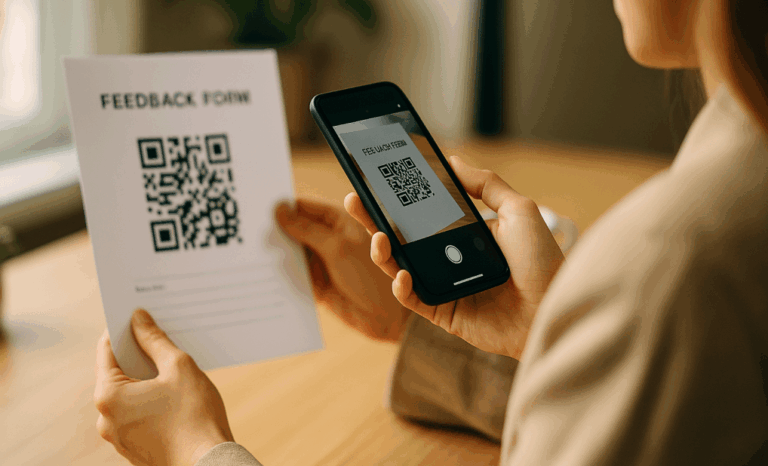Getting honest customer feedback is harder than it looks. People are busy, attention spans are short, and most surveys go unanswered. But what if the final step—sharing feedback—was as simple as pointing a phone at a code?
QR codes for customer feedback are helping businesses close the loop faster. Whether printed on a receipt, embedded in a product package, or displayed at a checkout counter, these simple tools bridge the gap between a customer’s experience and your data dashboard. And they do it in real time.
Let’s explore how this works, where to use it, and how to create feedback QR codes that actually get scanned.
Why QR codes are ideal for collecting customer feedback
Traditional feedback methods—email surveys, phone calls, comment boxes—are slow and often ignored. QR codes flip the script. They’re instant, low-friction, and designed for mobile-first behavior.
Customers already have their phones out. A well-placed quick response code (QR code) gives them a shortcut to share their thoughts in the moment, when the experience is still fresh.
By removing barriers like typing a URL or searching for a form, QR codes increase response rates and improve the quality of the feedback you collect.
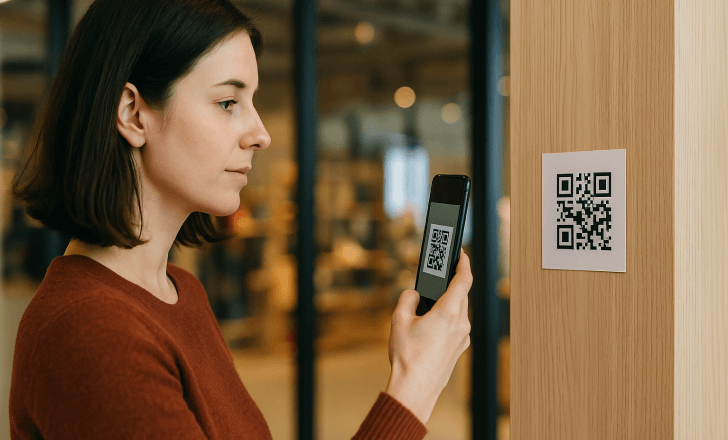
Where to place a feedback QR code for maximum engagement
The best feedback moments are embedded into real-world touchpoints. Here are some high-impact placements across various industries:
On receipts or invoices
Print a small dynamic QR code at the bottom with a prompt like “Tell us how we did.” It’s simple, unobtrusive, and works well in hospitality and retail.
Near exit gates or check-out counters
Physical materials like tabletop signs or posters near exits prompt users to scan the QR code right as they leave—ideal for gathering feedback from visitors, patients, or customers.
Product packaging
Let customers scan the code after they’ve unboxed your product to leave feedback, rate their satisfaction, or report issues.
In-app or on websites
If your customer interaction is digital, feedback QR codes still apply. Embed them into app screens or display them on desktop with a short explanation: “Scan to share your thoughts.”

How to create feedback QR codes that drive results
You don’t just want more feedback—you want better feedback. That starts with how you design the experience.
Use a dynamic QR code
This lets you change the destination without reprinting materials. So if your survey URL changes or you want to A/B test messaging, you won’t need a new code.
Keep the form short
A mobile-friendly survey design is essential. Focus on 3–5 core questions. Make it easy to respond with a few taps.
Customize your QR code
QR code customization—like adding your brand colors or logo—can increase trust and scan rates. Just make sure the contrast remains high enough for QR code readers to detect it.
Explain the benefit
Tell users what happens after the scan. “Scan to share feedback” is good. “Scan to rate your experience in 30 seconds” is better.
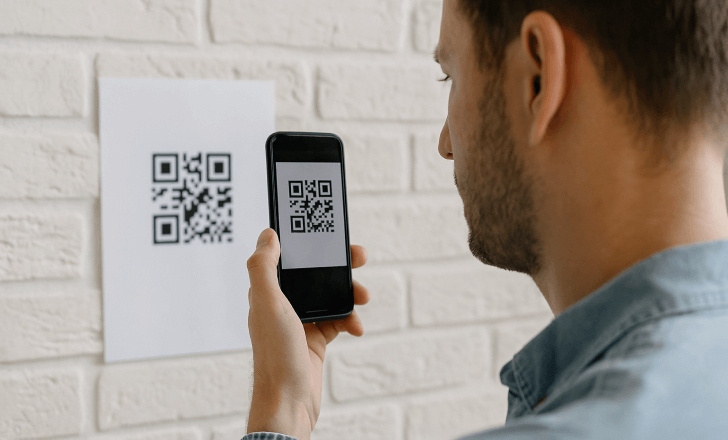
What kind of feedback can you collect with QR surveys?
Almost anything. From Net Promoter Score (NPS) to product reviews, QR surveys are a flexible tool. Here are some examples:
- Customer satisfaction: “How satisfied are you with your visit today?”
- Service quality: “Was our team helpful?”
- Product experience: “Is the product working as expected?”
- Bug reports or complaints: “Not happy? Let us know so we can fix it.”
By linking to a custom feedback page or form, you can tailor the questions to your audience and business goals.
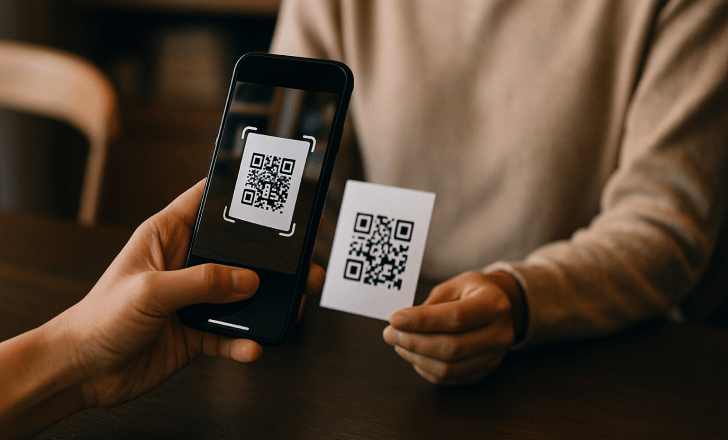
How do QR code surveys improve the customer experience?
When done right, QR code surveys don’t just gather data—they build trust. Here’s how:
- They show you care: Asking for feedback sends a strong message that you value the customer’s voice.
- They offer a voice to the silent majority: Most customers don’t bother calling support. But they might scan the QR code if it’s fast and easy.
- They lead to better service: Fast feedback means faster fixes. That’s a win for everyone.
And when you act on what you learn, you create a feedback loop that continuously improves the customer experience.
Examples of QR code feedback in action
A restaurant chain boosts response rates
One restaurant replaced paper comment cards with QR code surveys on receipts. With a simple “Scan to leave feedback,” they saw a 300% increase in survey responses.
A tech company tracks product satisfaction
After unboxing a device, customers are prompted to scan the QR code on the packaging. The code leads to a survey asking about first impressions, setup experience, and product quality. That data feeds directly into product teams.
A salon measures service quality
Using tabletop QR codes at check-out, a local salon gathers feedback on wait times, cleanliness, and staff friendliness—turning walkouts into insights.
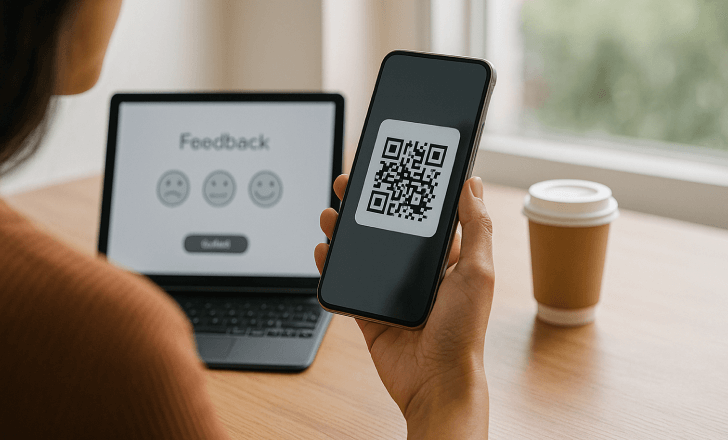
Can QR code feedback replace traditional surveys?
Not entirely—but it’s a powerful complement.
Email surveys often reach customers after the experience has faded. QR code surveys capture feedback in the moment. Together, they give you both immediacy and depth.
By incorporating QR codes into your survey strategy, you broaden your reach and catch valuable insights you’d otherwise miss.
How can you encourage more people to scan the QR code?
This is where design, placement, and messaging matter. Try these tips:
- Add a clear call to action: “Scan to win a gift card” or “Tell us what you think in 30 seconds.”
- Place it where people naturally pause—like near the door or on the thank-you page.
- Use a recognizable visual, like a star-rating image next to the QR code.
Even small changes to the feedback page can make users feel more comfortable sharing honest opinions.
What data can businesses collect from QR code surveys?
Using a smart QR code generator, you can collect:
- Survey responses
- Time and location of scans
- Device type (mobile vs tablet)
- Completion rates
- Conversion from scan to submission
This gives your team actionable data insights to guide everything from marketing campaigns to product improvements.
Why is QR code feedback great for printed materials?
You can’t embed a hyperlink in a paper receipt. But a two dimensional barcode solves that problem.
Printed QR codes extend the functionality of physical materials—flyers, posters, packaging—by linking to digital platforms instantly. It’s the missing link between offline interactions and online feedback collection.
How can QR feedback improve marketing campaigns?
Customer feedback is one of the most valuable inputs for marketing. QR codes make it easier to gather that input at scale.
Scan data can tell you what messaging works, where to invest more, and how customers feel about a campaign in real time. That helps you personalize future outreach and improve targeting.
Is it safe to collect feedback with QR codes?
Yes—especially if you’re using a trusted QR code platform. Choose a QR code generator that lets you create secure, branded links. You can even include a privacy disclaimer on the feedback form to reassure users.
Building customer trust is critical, and a safe, transparent feedback process helps you earn it.
How do I get started with QR codes for customer feedback?
Start with these steps:
- Define your goal: Do you want to measure customer satisfaction, improve service, or gather product feedback?
- Create your survey: Use a mobile-friendly tool or link to an existing feedback form.
- Generate your code: Use a dynamic QR code generator so you can update links later.
- Place it wisely: Think about where your customers finish their experience—in-store, online, or at home.
- Track and optimize: Analyze scan rates and survey responses to refine your approach.
Platforms like QR Code KIT make this easy, giving you all the tools to create, customize, and track your feedback QR codes from one place.
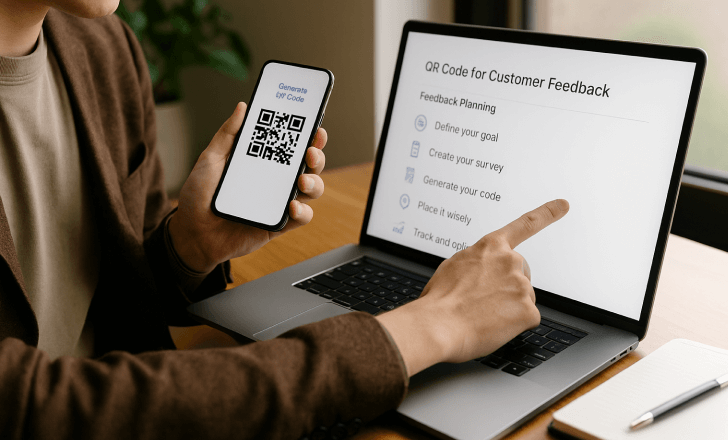
What industries benefit most from QR code surveys?
- Retail stores: Measure satisfaction at checkout or on packaging.
- Restaurants and cafés: Place codes on menus or receipts for instant feedback.
- Events and conferences: Gather real-time insights from attendees.
- Healthcare clinics: Let patients share feedback after check-in or post-visit.
- Hospitality: Hotels can add QR codes in rooms for service feedback.
In short, any business that interacts with customers—online or off—can benefit from using QR codes to gather feedback.
What’s the future of QR code feedback?
As more customers expect digital convenience, QR codes will become standard for gathering feedback. Expect smarter integrations with CRM tools, AI-powered survey analysis, and more personalized follow-up based on survey responses.
By giving users a simple way to share feedback, you unlock a continuous feedback loop that fuels better decisions, better service, and better business.

